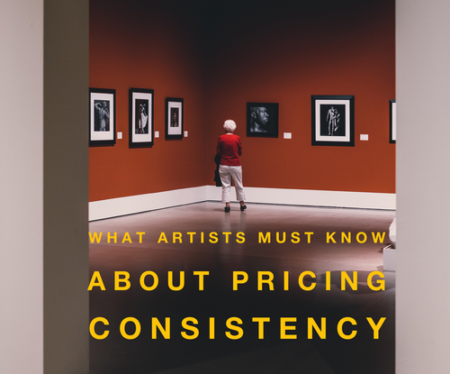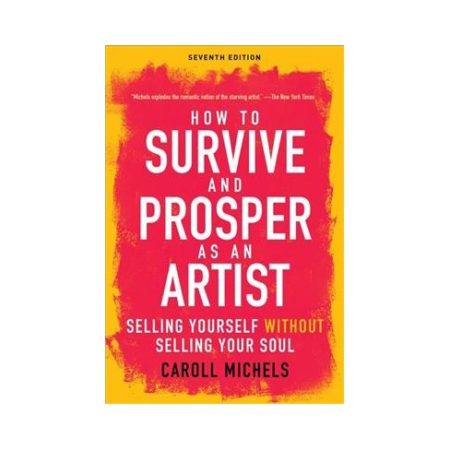Should a work of art always have the same price? How can artists be transparent? What do artists need to know about galleries and pricing?

Caroll Michels is a career coach, artist-advocate, and author with many years of experience working with artists. Her acclaimed guide, How to Survive & Prosper as an Artist: Selling Yourself without Selling Your Soul (New York: Allworth Press), now in its seventh edition, contains solid information for artists at all career levels. We recently spoke about a hot topic for many artists – pricing your work. She shares insights to help artists gain clarity and overcome the challenges that pricing can present.
AS: Why is art pricing consistency so important?
CM: Prices for your artwork must be universally consistent. This means that the retail price of artwork in the same medium and the same dimension must be listed for same price, regardless if it is being sold in Vienna, Virginia or Vienna, Austria.
Artwork is purchased for different reasons, which has less to do with investment and more to do with aesthetic pleasure. But most collectors entertain a fantasy that their purchases will increase in value. If artwork in the same medium and the same dimension sells for two different prices during the same period of time, the collector who purchased the work for more money might feel disheartened to learn that the market value of the work has declined. Reducing your market value penalizes the very people who believed in you and your work.
One way of taking measures to ensure that prices for your artwork are consistent is to include a retail price list on your website. This has a very important benefit: it can protect your work from the financial hanky panky that unfortunately transpires in the art world. In other words, unbeknownst to artists some art dealers have been known to charge collectors more than the agreed retail price stated on a consignment agreement, with art dealers pocketing the difference.
Unfortunately, auctions are a component of the art world in which artists have no pricing control. Over the years I have seen my clients’ artwork prices plunge as a result of auction sales, and with the plunge they are dropped by their galleries.

AS: What is “regional pricing” and why should artists avoid it?
CM: Regional pricing means that price of artwork is established based on the region where it is being sold. Regional pricing leads to inconsistency of prices. Artists sometimes allow work to be sold at certain prices in large cities but lower the prices if the work is exhibited in small cities or towns. This is a very bad idea. Regional pricing is insulting, supporting the elitist notions that people in small cities or rural areas are incapable of valuing art.
The chances are, if you are an artist living in a rural area or small city and are affiliated with a local gallery, you have been persuaded to price work at what the dealer thinks the local market will bear. A primary goal of many dealers is to “move” work quickly, and, unfortunately and erroneously, low prices are correlated with making a fast buck. The pricing policies of many dealers basically reflect the amount of money they think their constituencies will spend on art.
AS: How does this lead to choosing appropriate galleries and venues?
CM: We can’t be loved by everyone, and “rejection” is a fact of life that artists confront on an ongoing basis. Consequently, all too often artists quickly jump into the arms of galleries and art consultants/advisors without thinking things through and researching representation requirements that are in their best interest and not in their best interest. There are many important considerations on a variety of subjects when selecting appropriate sales venues, but narrowing down the subject to artwork prices, I suggest the following. Select venues that:
- Represent artists that sell work either in your current price range and/or in a higher price range, giving you “pricing breath” for the future.
- Readily agree to your prices and do not try to persuade you to lower your prices to accommodate their clientele.
- Absorb client discounts and do not require artists to award discounts. (As a negotiation point, you might be willing to split discounts if the client has previously purchased work from you or if the client is purchasing more than one piece simultaneously.)
- Are willing to put all of the terms of representation in writing in the form of an “artist-friendly” contract.
- Do not object to having a retail price list on your website.
- Honors “pricing consistency” and will make adjustments accordingly when the prices for your work are increased by other venues.


This is such important information! I too recommend this book! Thanks for sharing this Carolyn and thank-you Caroll for your smart contributions to the art community.
One of the issues that I see in my consulting practice is that artists often cannot comfortably discuss money, profit, and value. They avoid even putting prices on their websites, let alone give viewers opportunities to buy via a shopping cart.
It often boils down to fear. They are not confident in what they bring to collectors so pricing their work on the “affordable” side – whatever “that” is – becomes the comfort zone.
That said, I am compelled to invite your readers to be reminded of their unrivaled value. It’s all spelled out in the article I contributed here on Artsy Shark, called, “What is affordable art?” https://www.artsyshark.com/2014/07/08/what-is-affordable-art/
Bottom line: when an artist fully embraces the amazing impact they create every day, they will find more loving homes for their art. It’s the natural outcome of believing that your art impacts the very soul of our planet.
Thanks for the comment and the link, Mckenna. Pricing is one of the biggest challenges artists face, which is why this topic was chosen for the interview. Caroll has lots of good insights for artists, and her approach is quite similar to mine in advising artists.
Carrol Michels is an amazing inspiration and resource for both for emerging and well known artist. I have contact her over the years for advice giving me the support I need to confront the art world. Her insight into the needs of artist has developed over a lifetime of experience. If your looking for someone who can give you straight advice check her out.
Again Caroll Michels brings a solid perspective to an industry that needs more transparency. I have benefited over the years from fundamental concepts Caroll illuminates. Artists need to do the work they love and be prepared to stand up for it in the marketplace.
Is there discussion over how artists – such as photographers & Digital Artists – who must depend upon 3rd Party Vendors to reproduce their work – can understand the rule of thumb for pricing their artwork – considering the expenses of the vendor printer/framer, and the extra postage required for the Vendor’s return of reproduced artwork to the artist to sign, and/or frame/finish – before posting that finished artwork to the buyer? Is the a general consensus how much an artist should ‘mark-up’ their price over their expenses? Thanks – Brad
*Also, I just read, “Learn how your comment data is processed,” and I am still dizzy… Just to leave a comment, or question, and afterwards – reading all the implications of taking that action, and I feel like I have just had blood extracted at my local ER! It points to just how complicated doing business, today, in our ever-evolving digital information world is – where nothing, simply – not even a comment, goes without giving up a plethora of personal information. – bmm